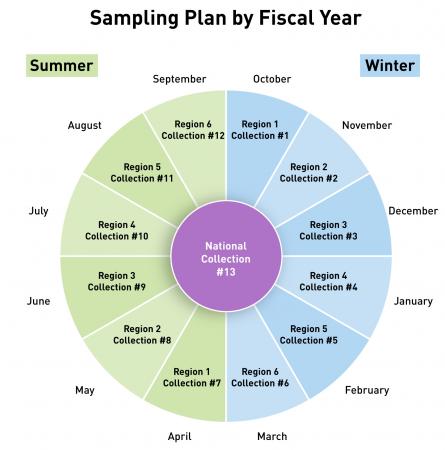FDA Total Diet Study (TDS): Design and Implementation
FDA Total Diet Study (TDS) Main Page
We made major changes to the FDA Total Diet Study (TDS) between 2014 and 2018. Starting in fiscal year 2018, the TDS includes a revised list of foods we sample, updated analytical methods, and a new sampling plan with six U.S. regions representing all 50 states.
In the current TDS, foods with nutrient or contaminant concentrations that are less likely to vary by location or by time of year are categorized as “national” foods. We obtain TDS national foods online or at retail outlets near our Kansas City Laboratory (Lenexa, KS). Foods with nutrient or contaminant concentrations that may vary by location or by time of year are categorized as “regional” foods. We collect the TDS regional foods in each of six U.S. regions (West, North Central, Northeast, Mid-Atlantic, Southeast, and Southwest). These regions have approximately equal population sizes.
Total Diet Study collection regions based on population size
The FDA district offices from across the U.S., under the Office of Regulatory Affairs (ORA), collect foods from retail outlets across the U.S.; these become the TDS samples. For national foods we collect products that comprise at least 50% of the market share for that food. For some national foods, to reach 50% market share, we combine products of different flavors or varieties into one composite sample for analysis. For example, based on research, we learned that blueberry, peach, and strawberry flavors of yogurt are the most popular, so we combine all three flavors together. For other national foods, only one or two products comprise 50% market share.
For regional collections, we identify the region the TDS samples will be collected from, according to our sampling plan. Our sampling plan ensures TDS samples are collected from across the U.S. Additionally, nutrient and contaminant levels in regional produce, dairy, and meat items may vary by time of year. We take this seasonality into account by collecting food samples in each region during each of two seasons (Winter: October - March and Summer: April – September), for a total of 12 regional sample collections a year (one per month).
Example of how the sampling plan allows us to identify seasonal differences in food concentrations
Within the region being sampled, we identify three sampling locations (cities). The sampled cities are chosen randomly under a plan in which more populated areas are more likely to be chosen as sample locations. Once these cities are chosen, we select three residential addresses at random within the selected cities. After that, we identify food retail outlets (such as grocery stores, warehouse stores, and restaurants) that represent the most likely food shopping options near the selected residential addresses. The list of food retail outlets is prioritized for our collectors so they can purchase the food samples efficiently. We collect the same list of foods from each of three selected cities within each region and ship the TDS samples to our Kansas City Laboratory.
TDS foods are collected from three cities in a region
For more information about specific foods sampled by the TDS, please visit FDA Total Diet Study (TDS): Foods and Dietary Exposure Estimation.
After we collect the TDS foods, we ship them to our Kansas City Laboratory (Lenexa, KS) for preparation and analysis. For many of the foods, we prepare and cook them the same ways consumers usually would. For example, we wash apples, peel bananas, and cook oatmeal. For the regional foods we combine the three collected samples into one composite regional sample.
For each TDS regional food, the samples from three cities in a region are combined into a composite sample
The TDS national and regional food samples, having been prepared at Kansas City Laboratory (Lenexa, KS) are each split into portions to be used in analysis of the following substances:
- elements (nutrient elements and toxic elements)
- pesticides
- radionuclides
The sample portions to be analyzed for elements (nutrient and toxic) and pesticides are analyzed at the Kansas City Laboratory. Only every other regional collection is analyzed for radionuclides and the sample portions are sent to the FDA's Winchester Engineering and Analytical Center (Winchester, MA).
Sample analysis
The FDA’s Center for Food Safety and Applied Nutrition (College Park, MD) provides overall management of the TDS and summarizes the laboratory results. After we have reviewed and finalized the results of the laboratory analyses, we post them on this website. For more information on the specific analyses performed, please visit the FDA Total Diet Study (TDS): Analytes and Analytical Methods page. The results can be found on the FDA Total Diet Study (TDS): Results page.
Data compilation, analysis, and application
If you have questions about the FDA Total Diet Study, email TDS@fda.hhs.gov.






